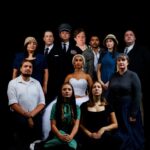The world is cruel. The world is ugly. But there are times and there are people when the world is not— and at its cruelest, it’s still the only world we’ve got. Sing the bells…bells…bells…bells…bells…bells— Bells of Woods Memorial Presbyterian Church!? I’m not sure those are the lyrics that Stephen Schwartz scribbled down initially, but you can hear the bells— of the phenomenal orchestra, the stellar choir, and the extraordinary cast— in their current resplendent production of The Hunchback of Notre Dame. A haunting story, tragically all too relevant for the current day and age, this beautiful Disney show is not the fluffy lightness of The Little Mermaid or other such fairyfloss-style shows that Disney is known for but rather a tragically beautiful deep dive into a dark blot in Parisian history. Directed & Musically Directed by David Merrill with Choreography by Elysia Merrill, and Choir commanded by Sarah Thompson & Alyssa Barlis, this evocative and sensational production will give you chills for days after experiencing it.
The court of miracles truly is set down inside the sanctuary of Woods Memorial Presbyterian Church; the wonders they achieve are both theatrically divine and truly wondrous. Some technical microphone hiccups aside on opening night, (chalk it up to the sound system and mics having opening night jitters) the show was nearly flawless. One of the most mesmeric and evocative theatrical experiences to behold. From an aural standpoint alone the music is astonishing and revelation-worthy. Between Orchestra Conductor Chris Pinder (and his sensational orchestra featuring Rich Estrin & Heidi Shultz on woodwinds, Diana Ogilvie on horn, Allyson Wesley on trumpet, Alan Becknell & Trent Goldsmith on keyboards, Hyejin Kim & Melody Flores on violin, Cindy Zhang on viola, Sarah Moore on cello, and Billy Georg on percussion) and Choir Leaders Sarah Thompson & Alyssa Barlis (leading their two-dozen-plus member choir, featuring: Dan Atkinson, Alyssa Barlis, Scott Benedict, Theresa Berkoski, Nancy Bishop, Kevin Cleaver, Susan T. Cooper, Kim Erickson, Ron Giddings, Karen Grant, Matthew Gray, Mary Jo Greenley, John Halmi, Emily Havnewitz, Doug Irminger, Lauren Mariah, Chelsea McCracken, Jane Merrill, Sarah Mitchell, David Nelson, Chris ‘Kit’ Smith, Alicia Sweeney, David Thompson, Sarah Thompson, Delight Yokanovich) it’s a Broadway caliber soundscape and that’s not even considering the principal and supporting characters. Alan Menken’s score is nuanced and complex, in addition to being iconic and well-recognized for lovers of the animated film, and both Pinder and the co-team of Thompson & Barlis do it superb justice in their skilled leadership of both orchestra and choir. When those initial soaring peels of music from “Olim” announce the start of the show, the choir is enchanting the audience with their angelic and dulcet tones; the effect of hearing the choir about a show that takes place in a sanctuary (while also physically taking place in a sanctuary) is soul-searingly spiritual.
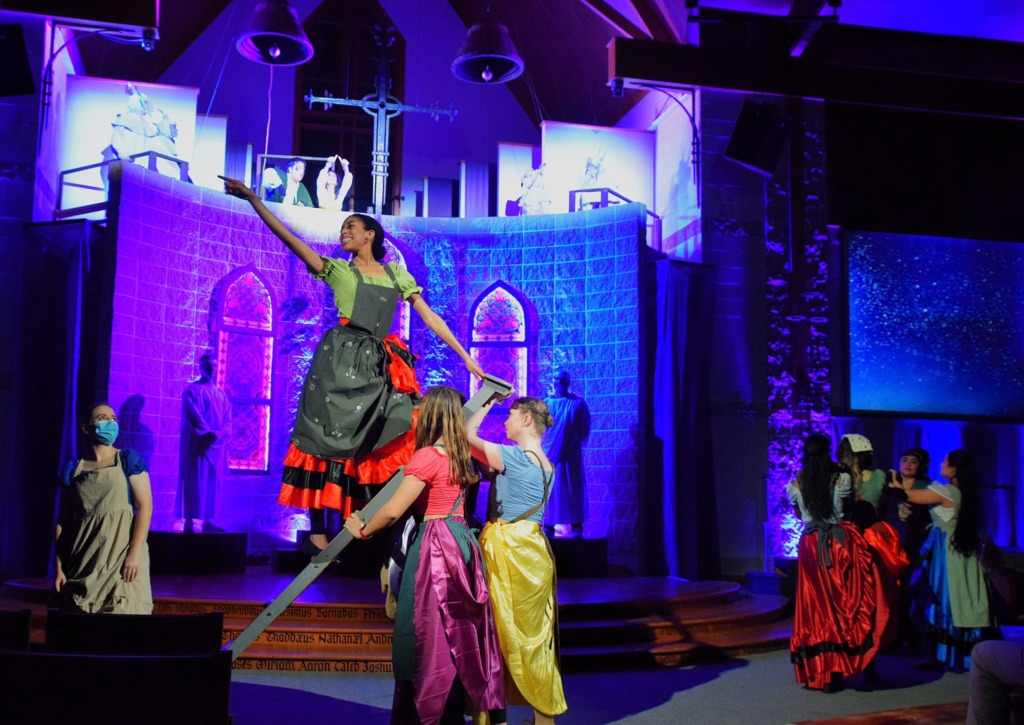
The fully stacked and gloriously-voiced choir is an integral part of The Hunchback of Notre Dame experience. They provide backing vocals and ensemble-style support for nearly every main number, including all of the traditional Catholic chants like the “Agnus Dei.” Their sound is indescribable; it’s transportive— pulling the audience along to the very steps, stones, and walls of Notre Dame without ever having to leave their seats inside the Severna Park church. Oft accompanied by ‘The Congregation’ (featuring but not exclusively limited to Beth Acton, Jazziel Baez, April Currey, Azalea Daw, Gabrielle Dorney, Gabriel Duque, Angela Germanos, Matt Gray, Taylor Hinds, Tonya Hogue, Avery Jackson, Sabina Lengbeyer, Jeffrey Maynard, Jane Merrill, Lindsey Miller, Jill Robinson, Cristina Rose, John Rose, Thomas Shade, Victoria Shute, Erica Snipes, Chris Swift, Rachael Swisher, Will Townsend, Cristal Santiago Vélez, Abby Wilson, Andy Kay Wojciehowski, Joel Wojciehowski), these two groups of vocalists fabricate the aural experience sublimely for this show. The Congregation take turns as narrative beacons, storytellers who feed us sung-lines of the adventure as it unfolds, particularly noticeable in numbers like “While the City Slumbered” and “The Bells of Notre Dame (Reprise II).”
Community Theatre, which at its heart thrives and survives because of its community is well in hand at Woods Memorial; the old adage of ‘it takes a village’ could not be more prevalent and noteworthy than with the village of people working on the creative team to make this production truly remarkable, astonishing, and so very praiseworthy. Scenic Artist Gigi Kingsland, working with Mark Bohlman & Pete Bishop (Set Builders) bring the Notre Dame Cathedral to life— stone-painted walls, with heavy cathedral doors (which fly apart during the siege on Notre Dame) all of which are augmented and enhances by Director David Merrill’s divine projections (two massive screens that flank either side of the stage.) Stained glass with light that filters through, gentle swinging bells, twinkling stars in the night sky, you name it; Merrill has included it all and it flows seamlessly one moment to the next against Bishop, Bohlman, and Kingsland’s scenic work on the set. If one projection-series seems to catch the eye above them all its when Merrill shapeshifts fiery flames into the dancing Gypsy Esmeralda during “Hellfire”; the imagery is so potent and cleverly executed that it paves the way for Frollo’s soul-warping solo to launch a direct assault on your heart.
Matching the aesthetic brilliance of the set (and all its moving components— one doesn’t wish to speak too much to the magic and miracles occurring with these set pieces because they’re so shocking and surprising to see at times that one doesn’t wish to spoil anything!) is Costume Masters Susan Bohlman, Jean Zemo, and Alysa Cripe accompanied by Hair & Makeup Artist & Team Kayley Blackwell, Anya Lengbeyer & Cassia Lengbeyer. Vivacious colors and patterns adorn all of the Gypsy Folk (comprised predominantly of the dance ensemble: Sierra Basilio, Morgan Binnix, Maura Campbell, Culley Fish, Anya Lengbeyer, Cassia Lengbeyer, Summer Moore, Lisa Pellittiere, Perry Swift, Violet Thompson, Shannon Vogel, Teagan Yokanovich) and they really add pops of vivacity for numbers like “Topsy Turvey” (and its reprise), “The Tavern Song (Thai Mol Piyas)” and “The Court of Miracles.” You also get some extraordinary craftsmanship from Sue Cooper, Sarah Thompson, and Trishelle Weed, who are credited with the fabrication and construction of the Gargoyle Headpieces. These whimsical additions to the production are a beautiful homage to the animated film and the three talking gargoyles who served as the hunchback’s only friends in that movie.
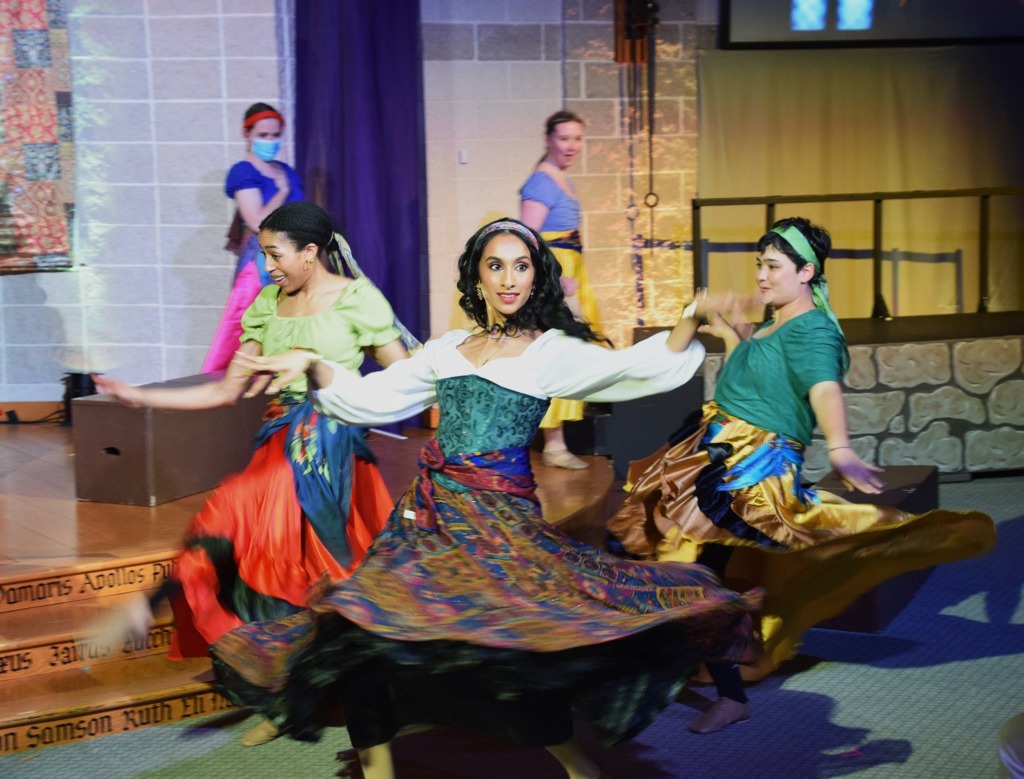
David Merrill, as the show’s director (and a great many other important hats), works in perfect unison alongside the show’s assistant director and choreographer, Elysia Merrill to activate the full potential of this production and each of the performers featured in it. There are so many strikingly beautiful and thought-provoking moments— the wholly-encapsulating moment near the show’s end (which for fear of spoilers cannot be truly described, but to say that it hits hard, fast, and unexpected at the heartstrings when the symbolism and meaning land, is an understatement!) is reflective of the Merrill’s vast understanding of the show. Just like the interpretive moment at the top of the show during ‘”The Bells of Notre Dame” where the origin story of Quasimodo is explained; the choice to take up the babe and toss him into the well/The Seine with the ‘Rain Dancers’ (several of the dance ensemble wearing rain-blue hooded costumes) toss the swaddled bundle about— it’s so striking. Lending itself to the symbolic representation of how Frollo sees the child— ‘a monster’ that perhaps was just an ordinary babe but due to his myopically pious focus, a half-gypsy child conceived out of wedlock could only be that— and it was his actions, his choice in that moment— throwing the babe into the water— that disfigured him; it’s a powerful and genius-interpretive moment. The same can be said for the powerfully evocative choices made when Frollo and Quasimodo have their confrontation; the physical choices in that moment and the overall execution of that— so striking and brilliant— it must be seen.
In addition to all of the intrinsic understanding that these two are putting into their work (not to mention all of the design work and craft) the pair find clever ways to keep the stage and play space from being overburdened with the innumerable members of cast, ensemble, and choir. Merrill and Merrill slide members of the ensemble, congregation, the guard, and Gypsies up and down the aisleways, around the main front play space, creating a sense of frenetic, perpetual motion without feeling overcrowded. Everyone on stage has a purpose. And their use of the actual ascending tower as— the bell tower— is remarkable. Herein, praises are also owed to Nancy Bishop and her properties team (Joelle Lengbeyer, Susan Luck, Jane Merrill, John Williams,) because the bells— yes, the bells of Notre Dame— have been hand-crafted and are marched in, full of ceremony, as they are hoisted up into the tower; it’s an awe-inspiring moment. And there are props all throughout the performance— like the pendant Esmerelda gives to Quasimodo— that just add that extra touch of polish and finesse to the overall theatrical experience. Fight Choreographer Tyler Heroux and Fight Captain Ryan New (along with intimacy choreographer Helen Aberger) are owed praises here as well; both of these integral components add to the completeness of the experience, particularly when tastefully staging violent scenes of swordplay and more sensual scenes of dance.
One could easily and readily sing the praises of the production team, louder and longer than any cathedral bell, but mere words could never do their efforts and execution justice. Though Elysia Merrill deserves even more praise for her work as the show’s choreographer (assisted by Matthew Walter.) Much of the show’s choreography is interpretive movement with dance moves and components to it, creating beautiful sweeps of twirling skirts and scarves among the Gypsies. You get a full parade of movement during both parts of “Topsy Turvey” wherein you get the Dance Ensemble (see above) really flaunting their capabilities as dancers— particularly Sierra Basilo and Anya Lengbeyer, who are performing tumbling acrobatic-tricks here. Merrill’s dances are tasteful yet evocative, inspiring the flavor and fullness of Romani culture, particularly when she incorporates the Gypsy skirts into her various dance routines.
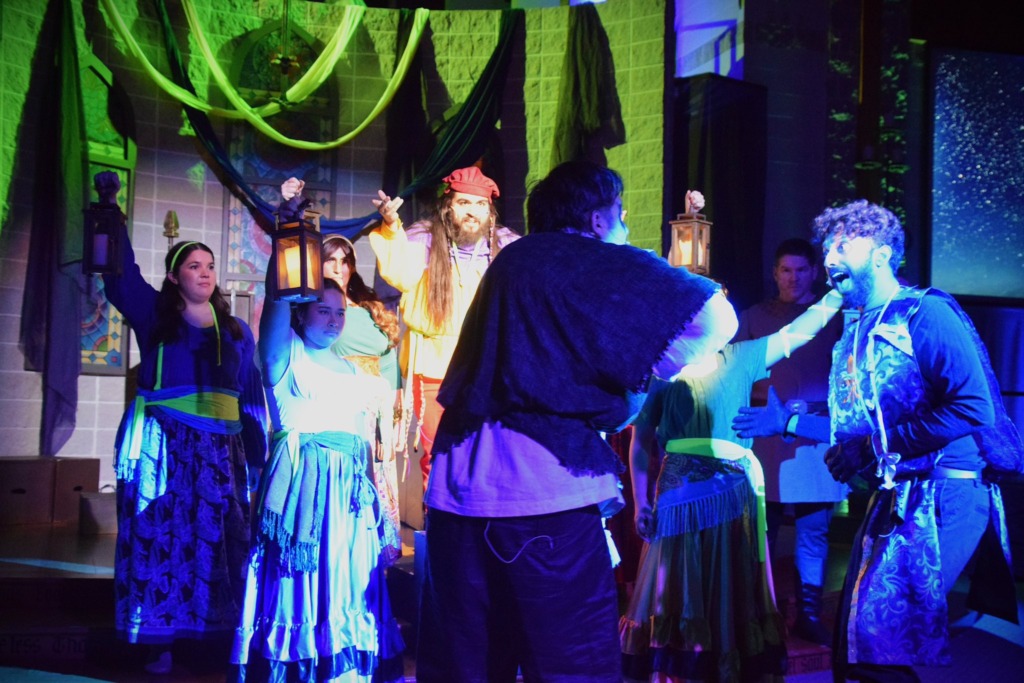
Hardly made of stone, though they do an excellent job of posing, the Statues (Garrett Crouch and Michael McDonald) have a humorous series of interactions— being physically manipulated about in a most hilarious fashion— when Esmerelda is trying to flee Phoebus in the sanctuary. Crouch and Michael have hearty and robust voices which often assist The Gargoyles (Kayleigh Berkoski, Abby Burns, Kaylee McDonald, Madelyn Luebbers, Joelle Lengbeyer.) While The Gargoyles stay up in the tower, Crouch and Michael exist on the cathedral floor and yet there is an interconnectivity between the bunch. When the Gargoyles deliver that harrowing vocal blow during “Made of Stone” it sends a precursory shiver up the spine, priming the audience emotionally for the powerhouse belt-blast of raw, expressions that Quasimodo uses to conclude that number. Berkoski, Burns, McDonald, Luebbers, and Lengbeyer are an adorable quintet of sincerity and lightheartedness. Mixed among these stone figures is St. Aphrodisius (David Thompson), who— let’s not get ahead of ourselves— is a pop-up cameo at the top of the second act, for the number “Flight Into Egypt.” Don’t be fooled, he may appear for just one number but Thompson’s voice is exquisite, perfectly pitched and intoned, with a fulsome carry for that song.
Other notable cameo characters, who then disappear into the ensemble like the magical way Esmerelda keeps escaping trouble, include Alysa Cripe and Keshav Swaminathan, playing Florika and Jehan, respectively. Though their named moments are brief, their roles are important as they lay the groundwork for our tale. Swaminathan in particular, who is simply given more lines in Peter Parnell’s libretto, is a character with whom the audience readily and deeply sympathizes with, particularly as he makes a final plea to his brother, Claude Frollo. You also get Dean Davis as Father Dupin and George King as King Louis XI, both with pop-up lines but delivered impeccably.
While the way the stage show shifts the narrative burden of the tale to the gargoyles, the congregation, the ensemble, and the players at large, Peter Parnell did not completely do away with the trickster character of Clopin (Ian Cripe.) This production even gives him a female-counterpart, simply identified as Clopin’s Sidekick (McKinsey Norris) and the pair are spotted everywhere together. Cripe serves as a ringleader to the Gypsies and his vocals are astonishing. Affecting a nasally sound to align with the slithery trickster nature of his character, Cripe is amusing in that dark and shadowy vein, though not without heart, particularly when it comes to ensuring that the Gypsies look out for their own. You can hear his voice in full during “The Court of Miracles” and certainly during both parts of “Topsy Turvey.” Cheeky and charming, Cripe froths up all sorts of chaos when he’s on the stage, Norris never far from his side to create balance in his appearance.
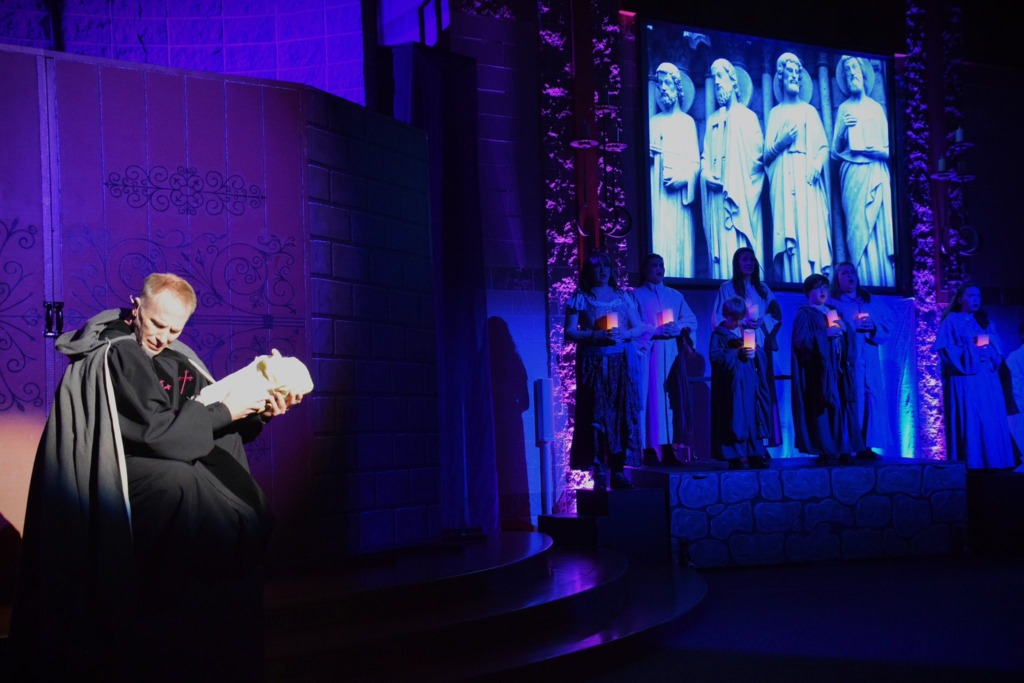
The main man of the guard may be Captain Phoebus (at this performance Jehan Silva) but his second-in-command support man, Lieutenant Frederic (at this performance, Ryan New) deserves acknowledgement as well. New, who leads the charge alongside Captain Phoebus at the end of the first act as the ‘Gypsy Hunt’ commences, has a surprisingly strong stage presence, despite the libretto giving him little to do until the second act. As for Jehan Silva, he has a lusty voice that settles perfectly into the score of “Rest and Recreation” Silva toes the line finely, balancing between his duty and his heart, which is not an easy feat, and he too has an impressive stage presence. His spatial awareness, particularly when doing the statue dodge-chase-sword-fight with Esmerelda is astonishing. Silva gives a nuanced portrayal, letting his voice blend and marry beautifully opposite of Esmerelda’s for “Someday”, which runs the risk of becoming sappy and saccharine. The pair transform this number into something transcendent, and when their voices unite in trio with Quasimodo for “In a Place of Miracles” there is sheer divinity ringing out across the sanctuary.
Joe Rose takes an intriguing approach to the antagonist of Claude Frollo. Where one might expect fury and villainy, anticipate loathing and treachery, Rose keeps the character’s emotions far closer to the chest, playing subtly, almost delicately. He certainly has a voice well-suited for the character’s song, particularly when it comes to blasting out (what should have been the Act I finale, but Disney, Menkin, Schwartz, and Parnell really missed the mark on organizing that one) “Hellfire.” The torment that percolates inside of him comes oozing out of Rose in that number sublimely. And his rich vocals are perfectly serviceable for “Sanctuary”, the duet he sings opposite Quasimodo early on. More reserved than the typical Disney villain, less nefarious than the standard musical theatre villain, Rose’s approach to Frollo almost makes him appear human, though not in a way that earns him any pity or sympathy from the audience. (Particularly when he pleads with Quasimodo at the end of the performance, the Gargoyles contradict him and the audience bursts into momentary titters of laughter at his pending plight.)
Enchanting, mesmerizing, and with a voice that could carry clear from the sanctuary floor up to the heavens above, Chinmayee Balachandra dons the mantle of Esmerelda (appearing from one of those mystical, aforementioned set-pieces) and dazzles the audience with her characterization, her dancing, and her singing. Sassy, taking no— ‘guff’— from anyone, and fully loaded with powerhouse vocals, Balachandra is a dizzying delight in the role. While the character of Esmerelda may be fiery, zesty, even bordering on dangerous (depending upon who you ask), Balachandra makes creates a dynamic performance with this role, particularly when she shows innocent, fully-intended tenderness and kindness toward Quasimodo. And when she first enters the sanctuary, eyes wide with wonder, blended with trepidation, it’s beautiful. Her solo (which is then filled with the voices of the entire cast and choir) “God Help the Outcasts” is stunning, sending wave after wave of emotion out into the audience, really hitting hard to the heart and soul as she embraces each of these lyrics that are all too relevant for today’s times.
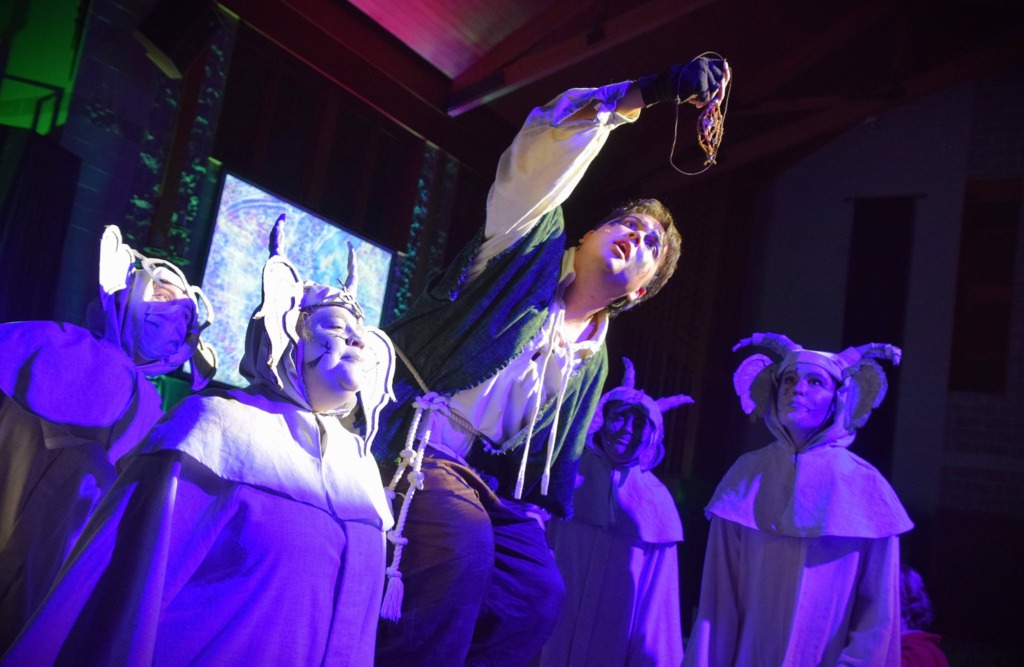
When one experiences a performance as moving, as gripping, as powerfully impactful as the one that Lucas White is giving in the titular role, one finds it a struggle to formulate cohesive sentences that could being to describe said performance with any hint of justice or accuracy. Aside from the fact that White possesses operatic-quality vocal capabilities and Broadway-level talent, the sheer dedication to fully immersing himself in the complex role of Quasimodo is phenomenal. The show is structured in such a way that you get to see the actor physically step into the role from amongst a hoard of others. So watching the physical consistency with which he lopes about, the way he commits to the overall physicality of the role— right down to the scrunched facial features and squinting eyes— is astonishing. The vocal affectation and adapted speech impediment (scripted as such to portray the character) are remarkable, especially when you hear the ‘true voice’ of Quasimodo singing; it’s breathtaking to hear the difference between the two and how readily White can transition from one to the other. “Out There” will have your heart soaring and your hands stinging from how hard you find yourself clapping when White concludes this number. The emotional fortitude with which White imbues Quasimodo is extraordinary. There are so many exquisite and divine moments with White in full-blown vocal sensationalism throughout this production, there could be a multi-page review on that alone. His pièce de résistance, however, arrives late in the second act, when heart, mind, body, and soul erupts like a fiery explosion during “Made of Stone.” The belted sustain at the end is enough to bowl you over. Add to it the unadulterated emotional current that blindsides the audience, the ferocity with which the whole number is delivered (and the perfect setup from The Gargoyles leading into it) and it’s theatrical devastator that shakes you through to your core to see it, hear it, feel it, and experience it. Lucas White is giving the performance of a lifetime as Quasimodo, the hunchbacked-bellringer in The Hunchback of Notre Dame.
It is a theatrical experience like no other; Woods Memorial Presbyterian Church has masterfully assembled this extraordinary community event and it is not to be missed. One weekend remains to catch this stunning, evocative, and all-but perfect production of The Hunchback of Notre Dame; do not miss it.
Running Time: 2 hours and 35 minutes with one intermission
The Hunchback of Notre Dame plays through April 6th 2025 with Woods Memorial Presbyterian Church— 611 Baltimore Annapolis Blvd in Severna Park, MD. Tickets are $20 and seating is LIMITED!! In order to register for seats, please visit this website or if registration is full and you’d like to be placed on the waiting list, please call Pam Ward at 443-261-3263 or email her at pward@woodschurch.org


